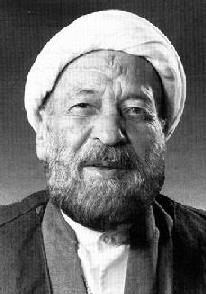
|
|
Abstract: Brief excerpt, with link to article offsite. Notes: See also Hojjatiya and Hojjatiyeh, Mesbahiyeh, and Ahmadinejad. The following is an excerpt of the article at www.iranicaonline.org/articles/halabi-shaikh-mahmud. |
Halabi, Shaikh Maḥmud Khorásání, founder of Hojjatiya
by Mahmoud Sadri
published in Encyclopaedia Iranica, Volume 11New York: Columbia University, 2003
 Shaikh Maḥmud Ḥalabi |
Ḥalabi’s later intellectual development was influenced by two seminal figures: First, a chance encounter with a clerical mystic, Shaikh Ḥasan-ʿAli Noḵodaki Eṣfahāni (1862-1942; Meqdādi; Ḥalabi, “Baḥṯi dar bāra-ye,” pp. 21-24) during which Ḥalabi was cured of a life-threatening illness, led him to choose the healing cleric as his mentor. In the following years, the otherwise rigorous philosopher undertook intense ascetic and mystical practices that involved prescribed cycles of seclusion and meditation (čella-nešini). This period coincided with an eight-year hiatus in the outskirts of Neyšābur at the height of Reżā Shah’s persecution of the clergy in the late 1930s and early 1940s. Although he later abandoned these esoteric practices, the experience left an indelible mark on his personality. Second, a series of debates with a renowned theosophist, Mirzā Mehdi Ḡarawi Eṣfahāni (1885-1945; Ḥalabi, Yādi az, pp. 21-26), during which Ḥalabi felt obliged to abandon his relentless defense of philosophy and to succumb to Mirzā Mehdi’s interpretation of kalām theology that excoriated the Hellenistic influences on traditional Islamic philosophy and called for a separation of secular philosophy from religious thought as well as a more vigilant adherence to the Shiʿite approach to the interpretation of Islam. This encounter led to four years of instruction during which Ḥalabi transcribed and edited Mirzā Mehdi’s teachings. The manuscripts of these lessons, along with Ḥalabi’s other philosophical commentaries from this period (Ḥa-wāši bar Manẓuma-ye Laʿāli,Šarḥ al-asmāʾ, and Šarḥ al-hedāya) are extant in Ketāb-ḵāna-ye Āstān-e Qods-e Rażawi in Mašhad. Ḥalabi’s lifelong devotion to this school of thought, which has come to be known as Maktab-e tafkik (Moḥmmad-Reżā Ḥakimi, pp. 5-26) was a result of his apprenticeship at this stage of his life.
Read the rest of this article online at www.iranicaonline.org/articles/halabi-shaikh-mahmud.
|
|